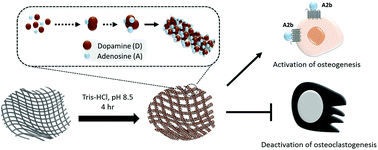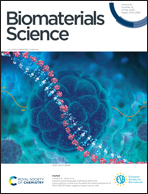Polydopamine-assisted one-step modification of nanofiber surfaces with adenosine to tune the osteogenic differentiation of mesenchymal stem cells and the maturation of osteoclasts†
Abstract
Adenosine and its receptors have emerged as alternative targets to control cellular functions for bone healing. However, the soluble delivery of adenosine has not proven effective because of its fast degradation in vivo. We therefore designed a stable coating of adenosine for biomaterial surfaces through polydopamine chemistry to control osteogenesis and osteoclastogenesis via A2bR signaling. First, we prepared electrospun poly (ι-lactic acid) (PLLA) nanofiber sheets, which were modified through a one-step adenosine polydopamine coating process. Scanning electron microscopy (SEM) revealed deposition of particles on the adenosine polydopamine-coated PLLA (AP-PL) sheets compared to the polydopamine-only sheets. Moreover, X-ray photoelectron spectroscopy analysis confirmed an increase in nitrogen signals due to adenosine. Furthermore, adenosine loading efficiency and retention were significantly enhanced in AP-PL sheets compared to polydopamine-only sheets. Human adipose-derived stem cells (hADSCs) cultured on AP-PL expressed A2bR (1.30 ± 0.19 fold) at significantly higher levels than those cultured on polydopamine-only sheets. This in turn significantly elevated the expression of Runx2 (16.94 ± 1.68 and 51.69 ± 0.07 fold), OPN (1.63 ± 0.16 and 30.56 ± 0.25 fold), OCN (1.16 ± 0.13 and 5.23 ± 0.16 fold), and OSX (10.01 ± 0.81 and 62.48 ± 0.25 fold) in cells grown in growth media on days 14 and 21, respectively. Similarly, mineral deposition was enhanced to a greater extent in the AP-PL group than the polydopamine group, while blocking of A2bR significantly downregulated osteogenesis. Finally, osteoclast differentiation of RAW 264.7 cells was significantly inhibited by growth on AP-PL sheets. However, osteoclast differentiation was significantly stimulated after A2bR was blocked. Taken together, we propose that polydopamine-assisted one-step coating of adenosine is a viable method for surface modification of biomaterials to control osteogenic differentiation of stem cells and bone healing.



 Please wait while we load your content...
Please wait while we load your content...